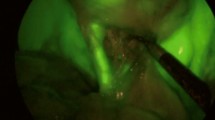Abstract
Background
Bile duct injury (BDI) as a complication of laparoscopic cholecystectomy may result in biliary cirrhosis with a high morbidity–mortality rate. Recurrent invasive procedures may be required for the optimum management. The most frequent causative factor in BDI is anatomical misidentification, particularly by inexperienced surgeons. Direct coloration of the cystic duct, bile duct, and gallbladder may decrease biliary tract injury.
Methods
This study was conducted during 10 standard, fresh cadaver autopsies at the Council of Forensic Medicine, Istanbul. Following needle puncture of the gallbladder fundus and aspiration of the bile content, identical quantities of isosulphan blue were injected into the gallbladder to visualize the biliary tract.
Results
Of the ten fresh cadavers, three were males and seven were females; the mean age at death was 43 years (range 22–76 years). Successful visualization of the colored biliary tract, encompassing the gallbladder, cystic duct, and bile duct, was achieved in all of the cadavers.
Conclusions
Visualization of the biliary tract may reduce the risk associated with dissection of Calot’s triangle. Surgical BDI risk following anatomical misidentification could be reduced by intraoperative injection of isosulphan blue; further studies are required to validate the clinical utility of this technique.



Similar content being viewed by others
References
Alvarez FA, de Santibañes M, Palavecino M et al (2014) Impact of routine intraoperative cholangiography during laparoscopic cholecystectomy on bile duct injury. Br J Surg 101(6):677–684
Buddingh KT, Nieuwenhuijs VB, van Buuren L, Hulscher JB, de Jong JS, van Dam GM (2011) Intraoperative assessment of biliary anatomy for prevention of bile duct injury: a review of current and future patient safety interventions. Surg Endosc 25(8):2449–2461
Figueiredo JL, Siegel C, Nahrendorf M, Weissleder R (2010) Intraoperative near-infrared fluorescent cholangiography (NIRFC) in mouse models of bile duct injury. World J Surg 34(2):336–343
Gien LT, Kwon JS, Carey MS (2005) Sentinel node mapping with isosulfan blue dye in endometrial cancer. J Obstet Gynaecol Can 27(12):1107–1112
Hirsch JI, Tisnado J, Cho SR, Beachley MC (1982) Use of isosulfan blue for identification of lymphatic vessels: experimental and clinical evaluation. AJR Am J Roentgenol 139(6):1061–1064
Iorga C, Cirimbei S, Strambu V, Popa F (2013) Intraoperative cholangiography still a current investigation. J Med Life 6(4):399–402
Leong SP, Donegan E, Heffernon W, Dean S, Katz JA (2000) Adverse reactions to isosulfan blue during selective sentinel lymph node dissection in melanoma. Ann Surg Oncol 7(5):361–366
Lumachi F, Norberto L, Zanella S et al (2011) Axillary node sampling in conjunction with sentinel node biopsy in patients with breast cancer. A prospective preliminary study. Anticancer Res 31(2):693–697
Mitra K, Melvin J, Chang S, Park K, Yilmaz A, Melvin S, Xu RX (2012) Indocyanine-green-loaded microballoons for biliary imaging in cholecystectomy. J Biomed Opt 17(11):116025
Sari YS, Tunali V, Tomaoglu K, Karagöz B, Güneyi A, Karagöz I (2005) Can bile duct injuries be prevented? “A new technique in laparoscopic cholecystectomy”. BMC Surg 17(5):14
Schols RM, Bouvy ND, Masclee AA, van Dam RM, Dejong CH, Stassen LP (2013) Fluorescence cholangiography during laparoscopic cholecystectomy: a feasibility study on early biliary tract delineation. Surg Endosc 27(5):1530–1536
Schols RM, Bouvy ND, van Dam RM, Masclee AA, Dejong CH, Stassen LP (2013) Combined vascular and biliary fluorescence imaging in laparoscopic cholecystectomy. Surg Endosc 27(12):4511–4517
Schols RM, Lodewick TM, Bouvy ND et al (2014) Near-infrared fluorescence laparoscopy of the cystic duct and artery in pigs: performance of a preclinical dye. J Laparoendosc Adv Surg Tech A 24(5):318–322
Schnelldorfer T, Jenkins RL, Birkett DH, Georgakoudi I (2015) From shadow to light: visualization of extrahepatic bile ducts using image-enhanced laparoscopy. Surg Innov 22(2):194–200
Sheffield KM, Riall TS, Han Y, Kuo YF, Townsend CM Jr, Goodwin JS (2013) Association between cholecystectomy with vs without intraoperative cholangiography and risk of common duct injury. JAMA 310(8):812–820
Schwendinger V, Müller-Holzner E, Zeimet AG, Marth C (2006) Sentinel node detection with the blue dye technique in early cervical cancer. Eur J Gynaecol Oncol 27(4):359–362
Sherwinter DA (2012) Identification of anomalous biliary anatomy using near-infrared cholangiography. J Gastrointest Surg 16(9):1814–1815. doi:10.1007/s11605-012-1945-z
Soper NJ (2011) Prevention of biliary leaks. J Gastrointest Surg 15(6):1005–1006
Spinoglio G, Priora F, Bianchi PP et al (2013) Real-time near-infrared (NIR) fluorescent cholangiography in single-site robotic cholecystectomy (SSRC): a single-institutional prospective study. Surg Endosc 27(6):2156–2162
Spinoglio G, Marano A (2013) Is the routine use of intraoperative cholangiography during laparoscopic cholecystectomy really the key to lowering bile duct injuries? Surg Endosc 27(12):4748–4749
Thomas KA, Lechner J, Shen P, Waters GS, Geisinger KR, Levine EA (2006) Use of sentinel node mapping for cancer of the colon: ‘to map or not to map”. Am Surg 72(7):606–611 (discussion 611–612)
Törnqvist B, Strömberg C, Persson G, Nilsson M (2012) Effect of intended intraoperative cholangiography and early detection of bile duct injury on survival after cholecystectomy: population based cohort study. BMJ 11(345):e6457
Strasberg SM, Hertl M, Soper NJ (1995) An analysis of the problem of biliary injury during laparoscopic cholecystectomy. J Am Coll Surg 180:101–125
Wear KD, Karsif K, Turner J (2003) Staining of endotracheal tube with isosulfan blue dye after sentinel node mapping: a case report. Breast J 9(1):47–48
Zuzak KJ, Naik SC, Alexandrakis G, Hawkins D, Behbehani K, Livingston E (2008) Intraoperative bile duct visualization using near-infrared hyperspectral video imaging. Am J Surg 195(4):491–497
Acknowledgments
We thank Prof. Dr. Fehmi Celebi and Associate Professor Fatih Altintoprak for comments that greatly improved the manuscript, also Prof. Dr. Sebiha Özkan for the review of the manuscript in terms of linguistic rules.
Conflict of interest
The authors declare no conflicts of interest.
Author information
Authors and Affiliations
Corresponding author
Rights and permissions
About this article
Cite this article
Ozkan, O.V., Yagmurkaya, O., Sahin, M.F. et al. Visualizing biliary tracts with isosulphan blue to prevent injury during laparoscopic cholecystectomy: a preliminary cadaveric study. Surg Radiol Anat 37, 1233–1237 (2015). https://doi.org/10.1007/s00276-015-1502-z
Received:
Accepted:
Published:
Issue Date:
DOI: https://doi.org/10.1007/s00276-015-1502-z




